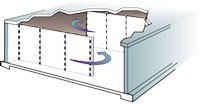| Home |
|
|
|
|
Online Store |

|
|
|
Sign up to receive our free Water Utility Tip of the Day
If you're visiting our website and the layout looks wrong, try going to your address bar and change the address from "https" to "http". We recently added SSL security to our site, but it is causing some pages to appear without formatting.
If you're visiting our website and the layout looks wrong, try going to your address bar and change the address from "https" to "http". We recently added SSL security to our site, but it is causing some pages to appear without formatting.
D.J. Gongol and Associates, Inc. are the exclusive manufacturer's representatives for Environetics baffles in the states of Iowa and Nebraska. Environetics baffles solve a variety of pollution-control problems and help you get more water treatment out of your budget!
DIRECTORTM III for public drinking-water disinfection.
Environetics Director III Clearwell Baffles help you meet the new requirements of the Safe Drinking Water Act. Attach the Environetics Director III baffles to your new or existing clearwell features to create a much longer flow path. Flowing water seeks the shortest path between two points, so many clearwells are subject to short-circuiting. Instead of mixing and being retained for the periods you expect, the water instead passes from inlet to outlet. This means most of the water is treated for less time than you expect, while some regions remain still within the tank and grow stagnant - creating a sort of "dead zone" within your clearwell.
Environetics clearwell baffles force the water passing through your clearwell to make the full trip through the basin. The actual linear distance that the water has to traverse between inlet and outlet becomes longer, and longer distances mean greater retention times and predictable disinfection results!
Clearwell baffles from Environetics also cut dead zones down to size by making more of your clearwell count.
Environetics clearwell baffles use high-quality, potable-grade materials approved by the EPA for public drinking-water systems. The panels that make up the baffles are flexible enough to roll or fold, making them easy to transport and virtually eliminating expensive structural modifications. Custom manufacturing, prefabricated panels, and specially-manufactured stainless steel fasteners mean you get quick, problem-free installation with minimal downtime.
Environetics is leading the way in creating dependable, efficient flow controls and water-retention systems. Contact us for custom specifications and calculations
last revised August 2009
DIRECTORTM III for public drinking-water disinfection.
Environetics Director III Clearwell Baffles help you meet the new requirements of the Safe Drinking Water Act. Attach the Environetics Director III baffles to your new or existing clearwell features to create a much longer flow path. Flowing water seeks the shortest path between two points, so many clearwells are subject to short-circuiting. Instead of mixing and being retained for the periods you expect, the water instead passes from inlet to outlet. This means most of the water is treated for less time than you expect, while some regions remain still within the tank and grow stagnant - creating a sort of "dead zone" within your clearwell.

|
Clearwell baffles from Environetics also cut dead zones down to size by making more of your clearwell count.
Environetics clearwell baffles use high-quality, potable-grade materials approved by the EPA for public drinking-water systems. The panels that make up the baffles are flexible enough to roll or fold, making them easy to transport and virtually eliminating expensive structural modifications. Custom manufacturing, prefabricated panels, and specially-manufactured stainless steel fasteners mean you get quick, problem-free installation with minimal downtime.
Environetics is leading the way in creating dependable, efficient flow controls and water-retention systems. Contact us for custom specifications and calculations
last revised August 2009



